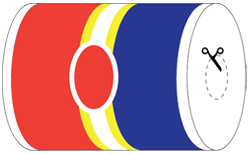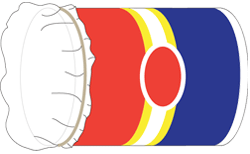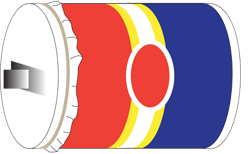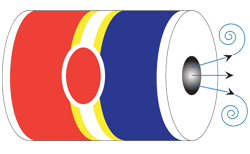Physics in a Toroidal Vortex: Air Cannon
You are about to build your very own toroidal vortex generator. This device will efficiently transport air across the room in a dazzling display of fluid dynamics.
What you Need
- oatmeal container
- plastic bag
- tape
- scissors or sturdy knife (Caution: Ask an adult to help you use these tools)




What to Do
First you want to cut a hole in the bottom of the bucket or oatmeal container. Cutting a hole in the cardboard of the oatmeal container will be easier than the plastic bucket. Use the scissors to puncture a hole in the center and then cut out a circle that is 2 inches in diameter. Don’t stress. The hole does not have to be perfectly circular as you will see later.
Next, tape the plastic bag over the opening that is opposite the hole. Make sure that you tape the bag to the container so that it does not contain any air leaks. The bag should be slightly taught. The taught flexible surface of the bag is called a membrane. It is important to have fancy names when your equipment is simple. Hence the membrane of your toroidal vortex generator sounds more sophisticated than the bag on your bucket.
Use a small piece of tape to make a handle on the center of the membrane that you can pinch with your fingers. Fold the tape so that it sticks to itself but leave the ends free to stick on the membrane.
Now you can pull and push on the membrane. Pull back slowly and push the membrane quickly while aiming the hole towards a target. Anything flexible makes a good target: your friend’s hair, posters, cats, candles (careful with fire and hot wax, ask an adult to assist you).
What’s Going On?
When the membrane thrusts a burst of air out of the hole, it displaces the surrounding air out side. The surrounding air swirls around in the shape of a twisting doughnut. The twisting doughnut will carry the original burst of air as far as 50 feet away.
The physics of moving air is called fluid dynamics. It may seem strange to call air a fluid but motion of gases and liquids are very similar. When a fluid twists or swirls, we call vortex. Again, note the advantage of using the fancy word vortex over the word swirl. Swirl is used when talking about the physics of ice cream. Can you think of where you might observe a vortex at home? Look in the Bath tub, sink or toilet. Now, our cannon generates very special vortices that differ from those found in the bathroom. They twist in the shape of a doughnut and the mathematical name for this is called a toroid. Hence our cannon generates toroidal vortices. Vortices are amazing phenomena because the motion of the air is stable and doesn’t require any outside intervention to keep it going. For instance, try blowing a burst of air with your mouth. This is a unstable burst of air that disperses by the time it reaches an arms length. A toroidal vortex on the other hand, will travel all the way across the room. Believe it or not, the mathematics of vortices is exciting too! You will find out when you get to college. When you get there, be sure to check the box labeled “PHYSICS” as your major.
Try This!
If you have a fog machine, then you can observe the shape of the toroidal vortex created by your air cannon. You can also put some flour inside the bucket and shake it up to simulate fog. If dry ice is available, that will work too.
See if you can use your toroidal vortex generator as smell cannon. Not all science has to be done with the eyes. Spray some perfume into the hole and see if you can send someone fragrant vortex. You can also try sending blasts of hot air or cold air.
Experiment with holes of different sizes. Will a smaller hole affect the velocity of the vortex? How small and how big can the hole be?
Experiment with holes of different shapes. Can you make a triangular fog vortex or a square?
What happens when two vortices crash into each other? Try it with a friend.
More Information
Variation of project with a 2 liter bottle
Dolphins like to do physics in their home too
Vortex collision videos:











